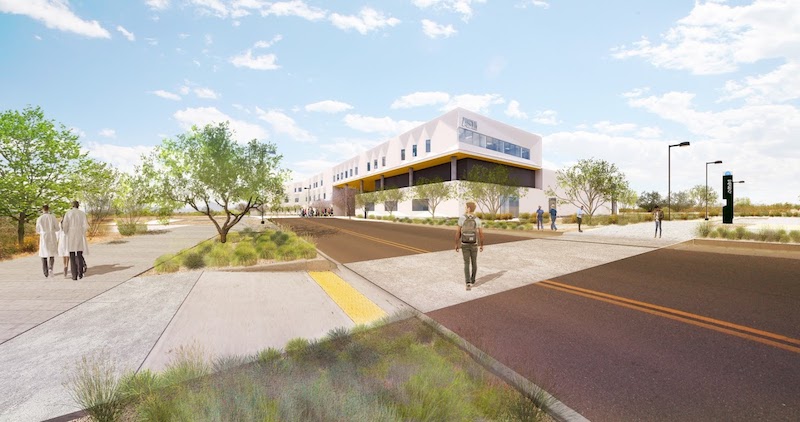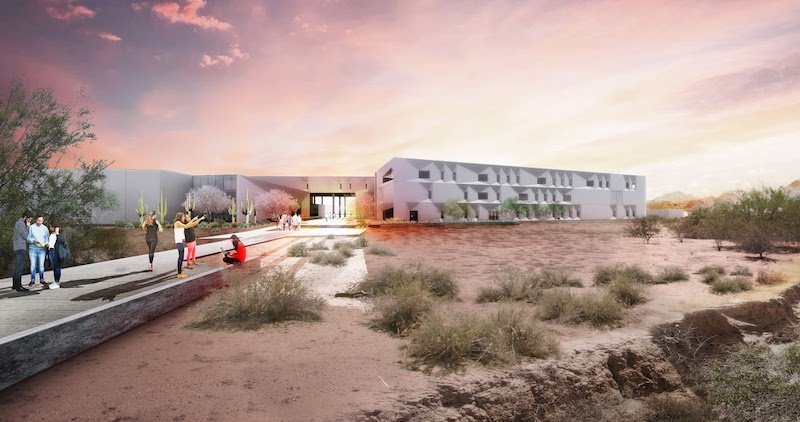The notion of open learning environments in higher education is trending, leading to the design of more collegiate buildings worldwide that are meant to remove barriers between students, faculty and disciplines.
Arizona State University’s Health Futures Center riffs on this popular design and educational idea, aiming to be a connecting place for interdisciplinary innovation, research, and medical simulation. Ground recently was broken on the facility, which is located adjacent to the Mayo Clinic campus, in northeast Phoenix.
The $80 million health care services facility will have a flexible framework, meant to support research and collaboration between the Mayo Clinic and ASU. The 142,000 SF building project’s groundbreaking was in April 2019; it is expected to be completed by late 2020. It is the first building on a new campus for ASU.
The building is meant to bring together the university’s College of Nursing and Health Innovation, College of Health Solutions, and the Ira A. Fulton Schools of Engineering, together with some shared programs of the Mayo Clinic.
The project was designed by CO Architects and DFDG Architects. CO Architects has expertise in developing such “hybrid” learning environments as is planned for the ASU facility.

“Our goal with ASU’s Health Futures Center is to create opportunities that maximize interdisciplinary collaboration and research in partnership with Mayo Clinic Phoenix, to help meet the mission of improving health outcomes,” says Jennifer Knudsen, AIA, LEED AP BD+C, Principal at CO Architects. “Our team designed the building to support a range of evolving interdepartmental research activities, industry partnerships, and teaching models through flexible, innovation-ready spaces.”
The under-construction building’s planned trapezoid façade is meant to decrease glaring from sun exposure on the structure’s east and west sides.
See Also: Sail on, Royal Caribbean: HOK-designed headquarters celebrates cruise ship industry
To speed work on the aggressively scheduled project, the CO/DFDG team collaborated with DPR Constriction’s pre-construction team, by way of the construction Manager at Risk method. The collaboration spawned a predictive cost-analysis tool, helping the project’s stakeholders prioritize needs and wants before the schematic design phase. This approach enabled the teams to design a building that fit needs and desires, and which will be within budget.
Through using Dassault Systemes’ 3DEXPERIENCE platform, the project’s designers streamlined and simplified the visual representation of the building’s complex geometry, enabling stakeholders to understand the structure’s design benefits.
CO Architects is the design architect, master planner, simulation planner, interior designer and laboratory planner for the building. DFDG is the project’s executive architect. DPR Construction is general contractor, ASE is serving as the structural engineer, Wood Patel is civil engineer, Jeremiah Associates, LLC, is performing AV/IT and acoustical, AEI Affiliated Engineers, Inc. is MEP engineer, and Floor Associates is performing landscape work on the project.
Related Stories
| Aug 11, 2010
3 Hospitals, 3 Building Teams, 1 Mission: Optimum Sustainability
It's big news in any city when a new billion-dollar hospital is announced. Imagine what it must be like to have not one, not two, but three such blockbusters in the works, each of them tracking LEED-NC Gold certification from the U.S. Green Building Council. That's the case in San Francisco, where three new billion-dollar-plus healthcare facilities are in various stages of design and constructi...
| Aug 11, 2010
Holyoke Health Center
The team behind the new Holyoke (Mass.) Health Center was aiming for more than the renovation of a single building—they were hoping to revive an entire community. Holyoke's central business district was built in the 19th century as part of a planned industrial town, but over the years it had fallen into disrepair.
| Aug 11, 2010
Right-Sizing Healthcare
Over the past 30 years or so, the healthcare industry has quietly super-sized its healthcare facilities. Since 1980, ORs have bulked up in size by 53%, acute-care patient rooms by 77%. The slow creep went unlabeled until recently, when consultant H. Scot Latimer applied the super-sizing moniker to hospitals, inpatient rooms, operating rooms, and other treatment and administrative spaces.
| Aug 11, 2010
Great Solutions: Healthcare
11. Operating Room-Integrated MRI will Help Neurosurgeons Get it Right the First Time A major limitation of traditional brain cancer surgery is the lack of scanning capability in the operating room. Neurosurgeons do their best to visually identify and remove the cancerous tissue, but only an MRI scan will confirm if the operation was a complete success or not.







